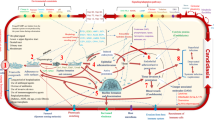Abstract
To date, the possible existence of “nonculturable” (NC) but potentially viable forms has been shown for some bacteria. NC mycobacteria have attracted particular interest due to the assumption that the latent form of tuberculosis is associated with the conversion of its causative agent, Mycobacterium tuberculosis, into the NC state. A number of approaches have been developed to obtain NC forms of mycobacteria, but the mechanisms of transition into or from this state have been insufficiently studied. This review considers cell-cell communications involved in the formation and reactivation of NC forms of the bacteria M. smegmatis and M. tuberculosis. Special attention has been paid to the secreted Rpf family proteins, which belong to peptidoglycan hydrolases and participate in the resuscitation of NC mycobacteria.
Similar content being viewed by others
References
Barer, M.R., Viable But Non-Culturable and Dormant Bacteria: Time To Resolve an Oxymoron and a Misnomer?, J. Med. Microbiol., 1997, vol. 46, pp. 629–631.
Kell, D.B., Kaprelyants, A.S., Weichart, D.H., Harwood, C.R., and Barer, M.R., Viability and Activity in Readily Culturable Bacteria: A Review and Discussion of the Practical Issues, Antonie van Leeuwenhoek, 1998, vol. 73, pp. 169–187.
Mukamolova, G.V., Kaprelyants, A.S., Kell, D.B., and Young, M., Adoption of the Transiently Non-Culturable State—a Bacterial Survival Strategy?, Adv. Microb. Physiol., 2003, vol. 47, pp. 65–129.
Wayne, L.G. and Hayes, L.G., An In Vitro Model for Sequential Study of Shiftdown of Mycobacterium tuberculosis through 2 Stages of Nonreplicating Persistence, Infect. Immun., 1996, vol. 64, pp. 2062–2069.
Wayne, L.G. and Sohaskey, C.D., Nonreplicating Persistence of Mycobacterium tuberculosis, Annu. Rev. Microbiol., 2001, vol. 55, pp. 139–163.
Parrish, N.M., Dick, J.D., and Bishai, W.R., Mechanisms of Latency in Mycobacterium tuberculosis, Trends Microbiol., 1998, vol. 6, pp. 107–112.
Gangadharam, P.R.J., Mycobacterial Dormancy, Tuber. Lung Dis., 1995, vol. 76, pp. 477–479.
Young, M., Mukamolova, G.V., and Kaprelyants, A.S., Mycobacterial Dormancy and Its Relation to Persistence, Mycobacterium: Molecular Microbiology, London: Horizon Bioscience, 2005, p. 352.
Khomenko, A.G. and Golyshevskay, V.I., Filterable Forms of Mycobacterium tuberculosis, Z. Erkrank Atm-Org., 1984, vol. 162, pp. 147–154.
Sever, J. and Youmans, G., Enumeration of Viable Tubercle Bacilli from the Organs of Nonimmunized and Immunized Mice, Am. Rev. Tuberc. Pulm. Dis., 1957, vol. 101, pp. 193–202.
Yamamura, Y., Walter, A., and Bloch, H., Bacterial Populations in Experimental Murine Tuberculosis, J. Infect. Dis., 1960, vol. 106, pp. 211–222.
McCune, R.M., Feldmann, F.M., Lambert, H.P., and McDermott, W., Microbial Persistence: I. The Capacity of Tubercle Bacilli To Survive Sterilization in Mouse Tissues, J. Exp. Med., 1966, vol. 123, pp. 445–468.
Shleeva, M.O., Bagramyan, K., Telkov, M.V., Mukamolova, G.V., Young, M., Kell, D.B., and Kaprelyants, A.S., Formation and Resuscitation of “Non-Culturable” Cells of Rhodococcus rhodochrous and Mycobacterium tuberculosis in Prolonged Stationary Phase, Microbiology (UK), 2002, vol. 148, pp. 1581–1591.
Shleeva, M.O., Mukamolova, G.V., Young, M., Williams, H.D., and Kaprelyants, A.S., Formation of “Non-Culturable” Cells of Mycobacterium smegmatis in Stationary Phase in Response to Growth under Suboptimal Conditions and Their Rpf-Mediated Resuscitation, Microbiology (UK), 2004, vol. 150, pp. 1687–1697.
Mukamolova, G.V., Kaprelyants, A.S., Young, D.I., Young, M., and Kell, D.B., A Bacterial Cytokine, Proc. Natl. Acad. Sci. USA, 1998, vol. 95, pp. 8916–8921.
Voloshin, S.A. and Kaprelyants, A.S., Cell-Cell Interactions in Bacterial Populations, Biokhimiya, 2004, vol. 69, no. 11, pp. 1555–1564 [Biochemistry (Moscow) (Engl. Transl.), vol. 69, no. 11, pp. 1268–1275].
Telkov, M.V., Demina, G.R., Voloshin, S.A., Salina, E.G., Dudik, T.V., Stekhanova, T.N., Mukamolova, G.V., Kazaryan, K.A., Goncharenko, A.V., Young, M., and Kaprelyants, A.S., Proteins of the Rpf (Resuscitation Promoting Factor) Family Are Peptidoglycan Hydrolases, Biokhimiya, 2006, vol. 71, no. 4, pp. 514–524 [Biochemistry (Moscow) (Engl. Transl.), vol. 71, no. 4, pp. 414–422].
Atrih, A. and Foster, S.J., The Role of Peptidoglycan Structure and Structural Dynamics during Endospore Dormancy and Germination, Antonie van Leeuwenhoek, 1999, vol. 75, no. 4, pp. 299–307.
Mukamolova, G.V., Turapov, O.A., Young, D.I., Kaprelyants, A.S., Kell, D.B., and Young, M., A Family of Autocrine Growth Factors in Mycobacterium tuberculosis, Mol. Microbiol., 2002, vol. 46, pp. 623–635.
Downing, K.J., Mischenko, V.V., Shleeva, M.O., Young, D.I., Young, M., Kaprelyants, A.S., Apt, A.S., and Mizrahi, V., Mutants of Mycobacterium tuberculosis Lacking Three of the Five Rpf-Like Genes Are Defective for Growth In Vivo and for Resuscitation In Vitro, Infect. Immun., 2005, vol. 73, no. 5, pp. 3038–3043.
Author information
Authors and Affiliations
Corresponding author
Additional information
Original Russian Text © E.G. Salina, G.N. Vostroknutova, M.O. Shleeva, A.S. Kaprelyants, 2006, published in Mikrobiologiya, 2006, Vol. 75, No. 4, pp. 502–508.
Rights and permissions
About this article
Cite this article
Salina, E.G., Vostroknutova, G.N., Shleeva, M.O. et al. Cell-cell interactions during the formation and reactivation of “nonculturable” mycobacteria. Microbiology 75, 432–437 (2006). https://doi.org/10.1134/S0026261706040114
Received:
Issue Date:
DOI: https://doi.org/10.1134/S0026261706040114




